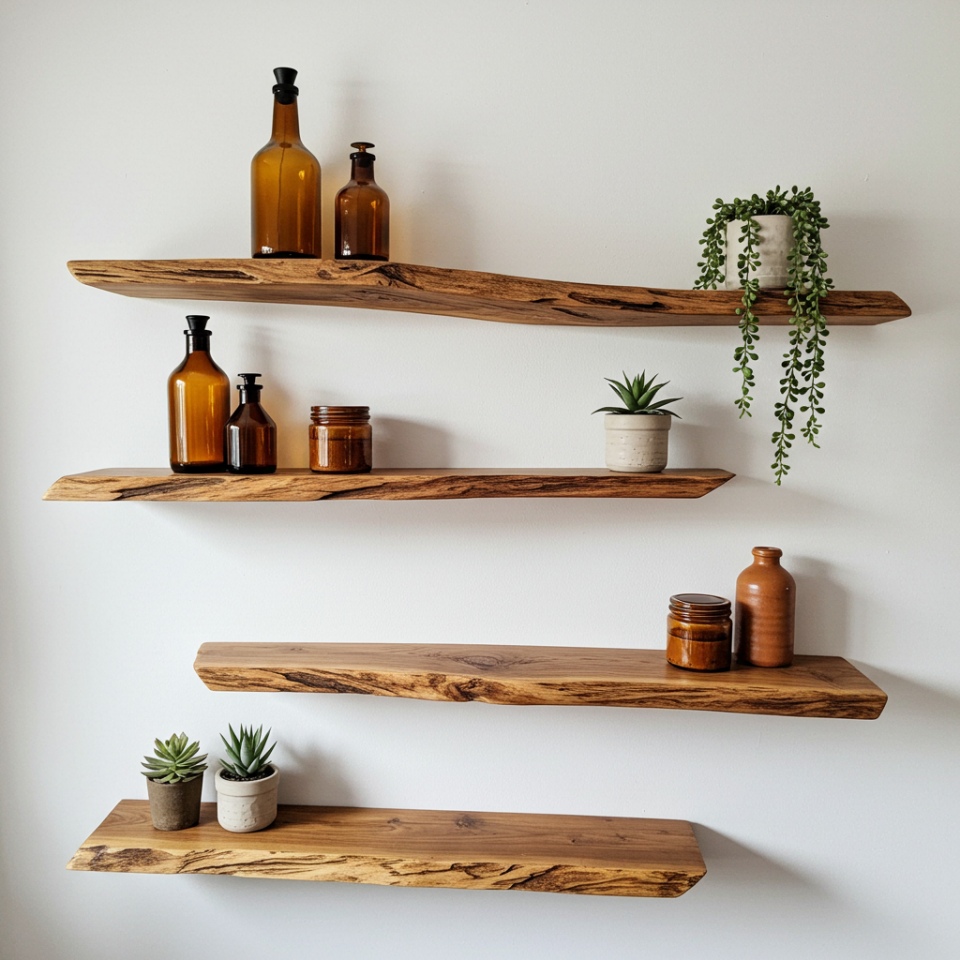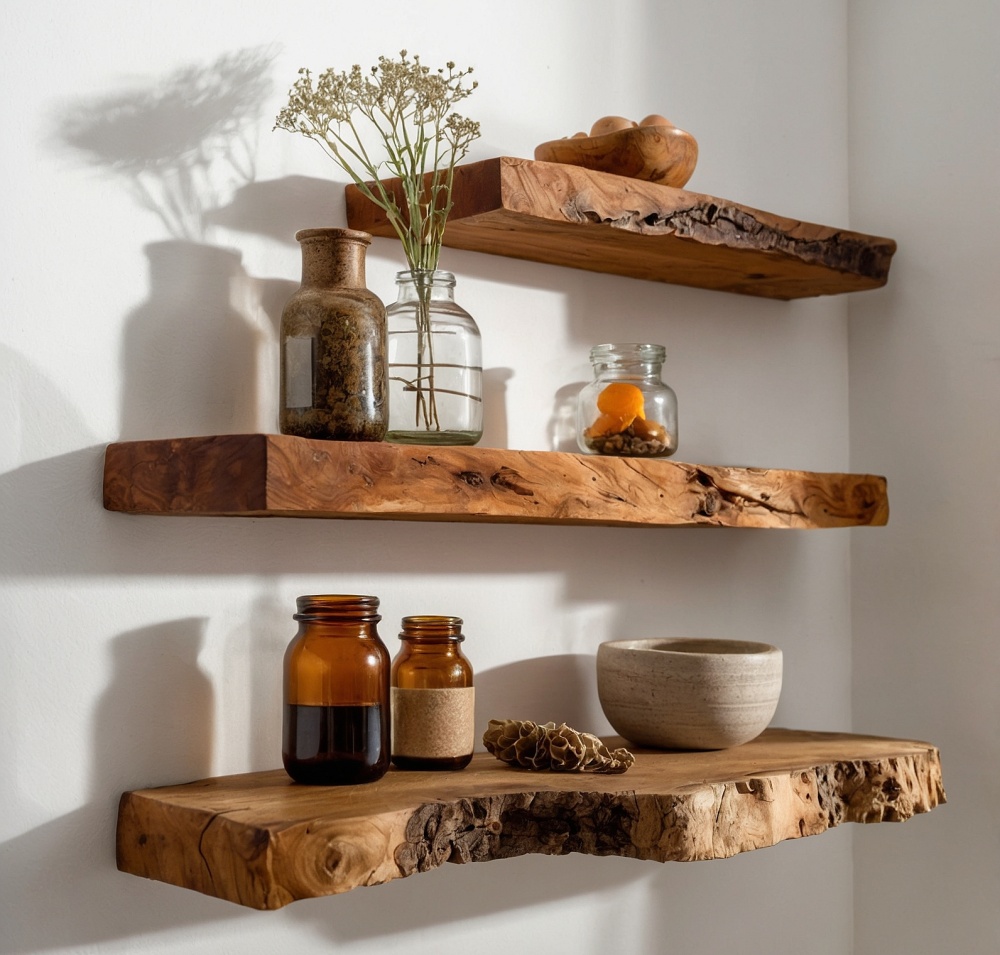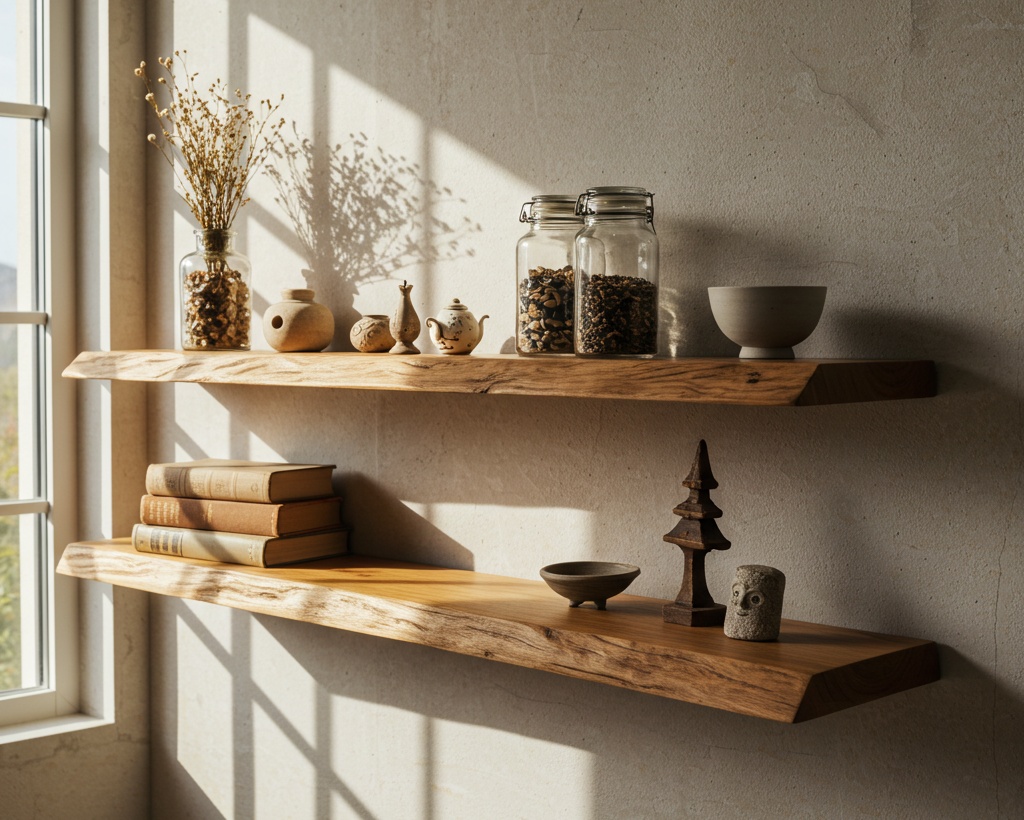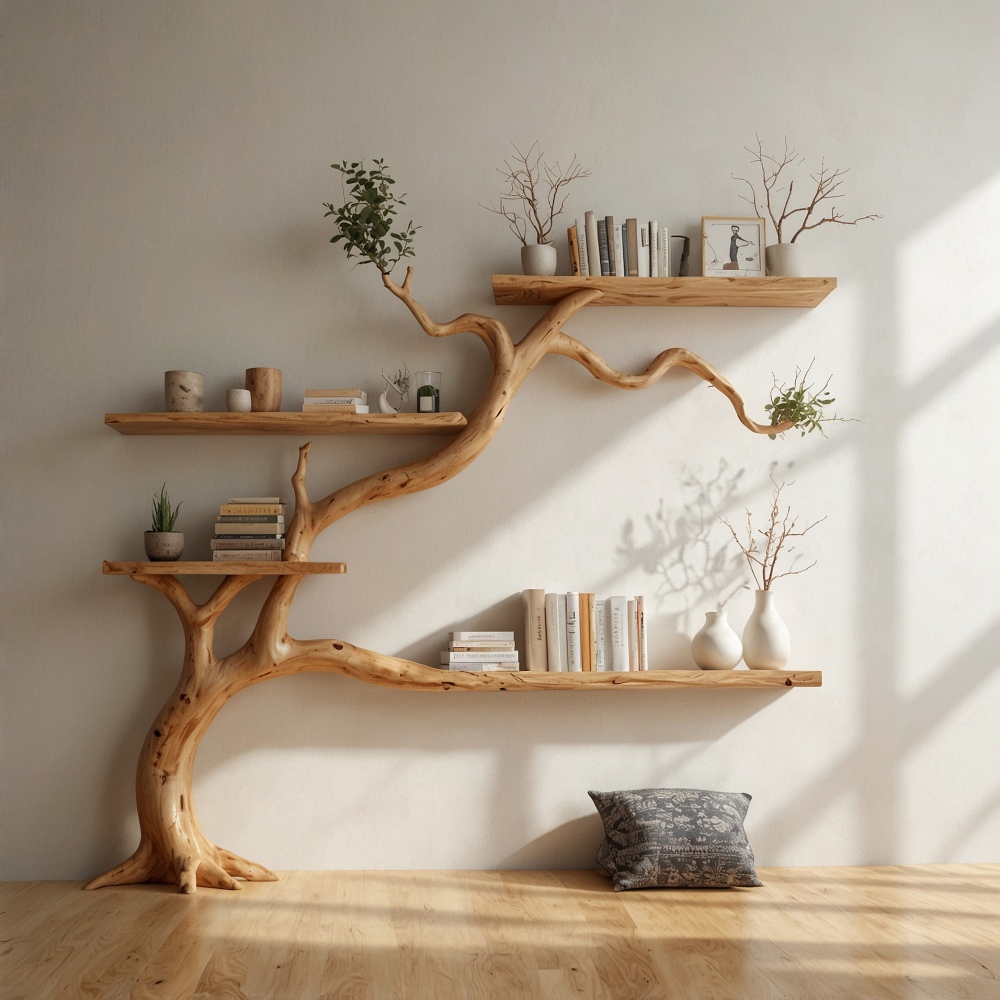Floating kitchen shelves have become a top trend in modern home design, offering a perfect blend of style and functionality. Unlike bulky cabinets that can make a kitchen feel cramped, floating shelves create an open and airy atmosphere. They provide a practical storage solution while allowing homeowners to showcase beautiful dishware, plants, or decorative pieces.
At DTWood Decor, we specialize in handcrafted wooden decor, including high-quality floating kitchen shelves. Whether you’re looking to maximize space in a small kitchen or add a rustic charm to your home, our shelves are designed to elevate your kitchen’s aesthetics while providing practical storage solutions.

In this guide, we’ll explore everything you need to know about floating kitchen shelves, from their benefits and materials to installation tips and design inspiration.
What Are Floating Kitchen Shelves?
Floating kitchen shelves are wall-mounted shelves designed to appear as if they are “floating” without any visible brackets or supports. This sleek design creates a minimalist and modern look, making them a popular choice for homeowners who want to keep their kitchens stylish yet functional.
How Do Floating Shelves Work?
Unlike traditional shelves that rely on bulky brackets, floating shelves are mounted using hidden internal brackets or support systems. These are typically secured into wall studs, ensuring stability and durability. This makes them ideal for storing everyday kitchen essentials like dishes, glassware, and spices while keeping the space visually uncluttered.
Materials Used for Floating Kitchen Shelves
Floating shelves come in various materials, each offering a unique aesthetic and level of durability:
- Solid Wood: A classic and durable choice, perfect for rustic, farmhouse, or modern kitchen styles. Our handcrafted wooden shelves at DTWood Decor are made from high-quality, sustainably sourced wood.
- MDF (Medium-Density Fiberboard): A budget-friendly alternative that offers a smooth, polished look.
- Metal: Ideal for industrial-style kitchens, metal shelves provide a sleek and sturdy option.
- Glass: Perfect for a contemporary kitchen, though it requires frequent cleaning to maintain its transparency.
Wooden floating shelves remain the most popular option due to their warmth, versatility, and durability. They can be stained, painted, or left in their natural state to complement various kitchen styles.
Benefits of Floating Kitchen Shelves
Floating shelves kitchen are more than just a trendy design choice—they offer practical advantages that make them a favorite among homeowners and interior designers alike. Here are some of the top benefits:

1. Space Optimization
Traditional cabinets can make a kitchen feel small and cramped. Floating shelves, on the other hand, open up the space by eliminating bulky structures, making even tiny kitchens feel larger and more breathable.
2. Aesthetic Appeal
Floating shelves create a sleek, modern, and uncluttered look. They allow you to display beautiful dishware, plants, or decorative items, adding personality and charm to your kitchen. Whether you prefer a rustic farmhouse vibe or a minimalist contemporary style, floating shelves can enhance your kitchen’s overall aesthetics.
3. Easy Accessibility
No more digging through deep cabinets! With floating shelves, everything you need is within easy reach. This is especially useful for frequently used items like plates, cups, spices, or cooking oils.
4. Customization Options
Floating shelves come in a variety of materials, colors, and finishes. At DTWood Decor, we offer handcrafted wooden shelves that can be customized to fit your kitchen’s style, whether you want a natural wood grain look or a painted finish to match your decor.
5. Cost-Effective
Compared to traditional cabinets, floating shelves are a more budget-friendly option. They require fewer materials and are easier to install, saving both money and time.
Choosing the Right Floating Kitchen Shelves
Selecting the perfect floating shelves for your kitchen depends on several factors, including material, size, weight capacity, and design style. Let’s break it down:
1. Material Considerations
- Solid Wood: Durable, stylish, and versatile. Works well in both modern and rustic kitchens.
- MDF (Medium-Density Fiberboard): Smooth and affordable but less durable than solid wood.
- Metal: Great for industrial or contemporary kitchens, but may not support as much weight.
- Glass: Adds a sleek, modern touch but requires frequent cleaning.
At DTWood Decor, we recommend solid wood floating shelves for their timeless beauty, strength, and ability to support kitchen essentials.
2. Weight Capacity
Before installing floating shelves, consider what you plan to store on them. Different materials have different weight limits:
- Standard wooden floating shelves can typically hold 20-50 lbs per shelf when properly installed.
- If you plan to store heavy items like large cookware or heavy dishes, opt for thicker shelves and sturdy wall anchors.
3. Size & Depth
- Shallow Shelves (6”-8” deep): Ideal for spices, glasses, and decorative items.
- Medium Shelves (10”-12” deep): Great for plates, bowls, and cookbooks.
- Deep Shelves (14”-16” deep): Best for storing larger kitchen appliances or pantry items.
4. Matching with Your Kitchen Design
- Rustic Farmhouse: Opt for natural or reclaimed wood shelves with visible knots and grain.
- Modern Minimalist: Choose sleek, painted shelves with a clean finish.
- Industrial Style: Metal brackets with wood or steel shelves for an edgy look.
- Scandinavian: Light wood shelves with a simple, airy aesthetic.
Floating kitchen shelves are not just practical—they’re also a design statement. Choosing the right shelves will enhance both functionality and style in your space.
Installation Guide: How to Install Floating Kitchen Shelves
Installing floating kitchen shelves might seem intimidating, but with the right tools and steps, it can be a straightforward DIY project. Follow this step-by-step guide to ensure a secure and stylish installation.

Tools & Materials Needed
✅ Floating kitchen shelves (wood, MDF, or other preferred material)
✅ Stud finder
✅ Measuring tape
✅ Level
✅ Drill and appropriate drill bits
✅ Wall anchors (if not drilling into studs)
✅ Screws and brackets (if required)
✅ Pencil for marking
Step-by-Step Installation Process
Step 1: Measure and Mark the Wall
- Use a measuring tape to determine where you want to place your shelves.
- Mark the spots on the wall with a pencil, ensuring they are evenly spaced.
Step 2: Locate Wall Studs
- Use a stud finder to locate the wooden studs in the wall.
- If possible, install the shelves directly into the studs for maximum support.
- If studs are not available, use heavy-duty wall anchors to ensure stability.
Step 3: Install the Mounting Hardware
- If your floating shelves come with internal brackets, secure them into the studs using a drill and screws.
- If your shelves are bracket-free, follow the manufacturer’s instructions to attach the hidden mounting system.
Step 4: Mount the Shelves
- Carefully slide or secure the shelves onto the mounted hardware.
- Use a level to ensure they are straight before finalizing the installation.
Step 5: Test for Stability
- Gently apply pressure to check if the shelves can support weight without wobbling.
- Avoid placing heavy objects on the shelves immediately—gradually add items to prevent strain.
Common Mistakes to Avoid
❌ Overloading the Shelves: Exceeding weight limits can cause shelves to sag or fall.
❌ Not Using a Stud Finder: Installing on drywall alone can lead to weak support.
❌ Skipping the Leveling Step: Uneven shelves can affect both aesthetics and functionality.
Best Uses for Floating Kitchen Shelves
Floating shelves are incredibly versatile and can be used for both storage and decoration. Here are some creative ways to use them in your kitchen:
1. Storing Everyday Kitchen Essentials
- Keep frequently used plates, bowls, and glasses within easy reach.
- Store spice jars, cooking oils, and condiments for convenient access.
2. Decorative Display
- Arrange houseplants, candles, or framed pictures for a stylish look.
- Showcase unique pottery, vintage dishes, or handcrafted wooden decor from DTWood Decor.

3. Coffee Bar or Beverage Station
- Use floating shelves to organize coffee mugs, coffee beans, and accessories.
- Add hooks underneath for hanging cups or small utensils.
4. Pantry Extension
- Store dry goods like pasta, rice, and baking supplies in glass jars for a neat and stylish pantry display.
- Use labeled baskets or containers for easy organization.
5. Cookbook Storage
- Display your favorite cookbooks for both convenience and visual appeal.
Floating shelves don’t just add beauty to your kitchen—they also make it more efficient and organized.
Maintenance & Cleaning Tips
To keep your floating kitchen shelves looking beautiful and functional, follow these maintenance tips:
Regular Dusting
- Use a microfiber cloth or a soft duster to remove dust and prevent buildup.
Protecting Wooden Shelves
- If your shelves are made of wood, consider sealing them with a protective finish to prevent moisture damage.
- Avoid placing wet items directly on the shelves.
Cleaning Grease and Stains
- Kitchens can be greasy, so wipe shelves regularly with a damp cloth and mild soap.
- For wooden shelves, avoid harsh chemicals that may damage the finish.
Preventing Overloading
- Check the weight capacity of your shelves and distribute items evenly.
- If you notice sagging, reduce the load or reinforce the shelves with additional brackets.
Conclusion
Floating kitchen shelves are a stylish, space-saving, and functional addition to any home. Whether you want to create an open, airy feel, display beautiful kitchenware, or improve organization, these shelves offer endless possibilities.
At DTWood Decor, we specialize in handcrafted wooden floating shelves made from high-quality, sustainably sourced wood. Whether you’re looking for a modern minimalist look or a rustic farmhouse charm, we have the perfect shelving options to transform your kitchen.


